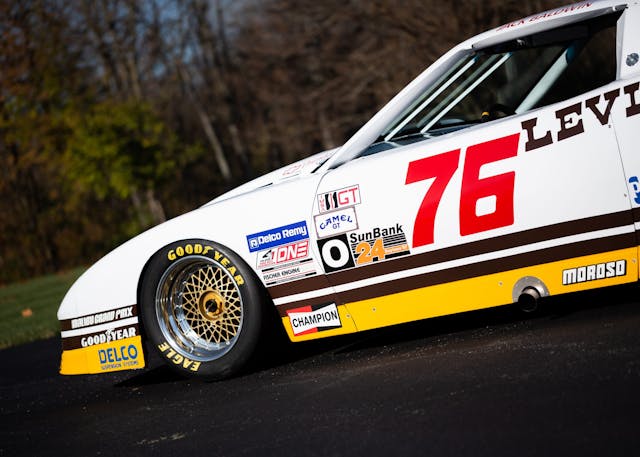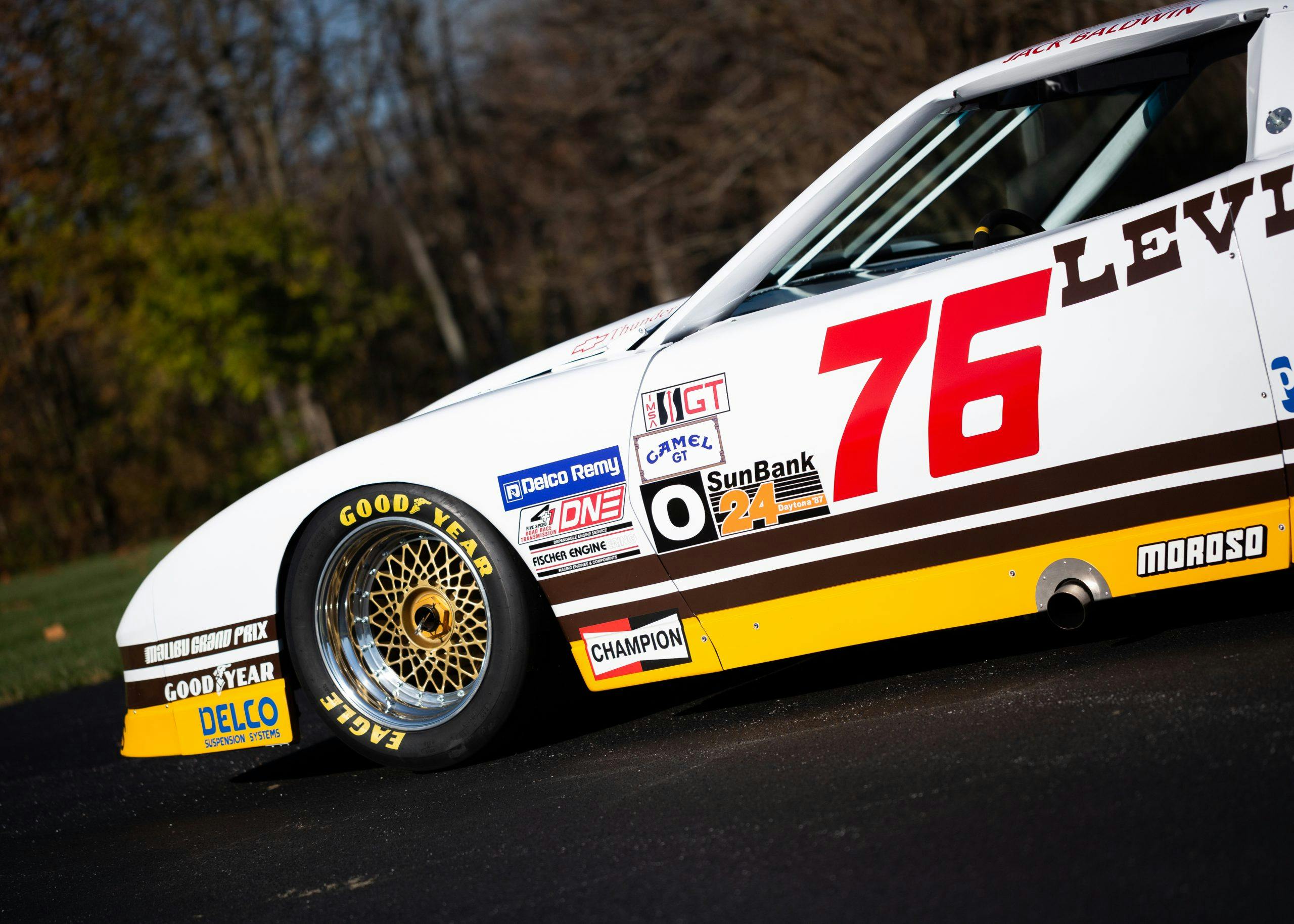Media | Articles
6 race-ready cars up for grabs at Amelia 2022
If you’ve ever spent the night at a race track ahead of a big event, you know there’s something about that first crank of an unmuffled race engine breaking the morning silence. The air suddenly lopes with anticipation; it’s time to start the day. That time is just about here for the annual Amelia Island auctions, which usually teem with desirable race cars. Sure, crossing the auction block is a wee bit slower than crossing a finish line, but we still can’t wait to see them perform.
Like all collector car values, race car prices are influenced by many factors. Some are rarer, others have stronger provenance, and some simply put a big smile on your face—and a dent in your wallet. Of course, event eligibility and ease of ownership also affect value. What good is a race car if you either can’t easily rouse it from slumber or have nowhere to use it?
There’s also the issue of originality, and let’s face it: Very few race cars that ever turned their share of laps in anger are going to retain its factory original componentry. Perhaps that vintage Ferrari received an expensive love tap at Goodwood. Or, that Porsche you have your eye on sent a rod through the the original block at an enduro decades ago. Race car collectors are well aware that things happen on track, so it’s often the extent and quality of the repair that makes the difference. That non-original engine might be forgiven based on the racing success of the chassis, or perhaps having a champion win in a particular car isn’t as powerful as buyer demand for a particular marque. It all comes down to individual nuances and preferences.
What’s more, a significant amount of collector race cars escape the confines of the climate controlled garage; increasingly, buyers want a chance to experience their new track-only purchase. “Buyers tend to pay more for a car if it has a good intended use,” says Colin Comer, Hagerty’s in-house vintage race car expert. “By ‘good,’ I mean that there’s a healthy class for that car at vintage races, or it’s eligible to run in events like the Mille Miglia or Colorado Grand.”
How will this crop of racers fare next week at Amelia? We’ll be there to cover it when the green flag drops.
Marketplace
Buy and sell classics with confidence
1974 Porsche 911 Carrera 3.0 RSR IROC
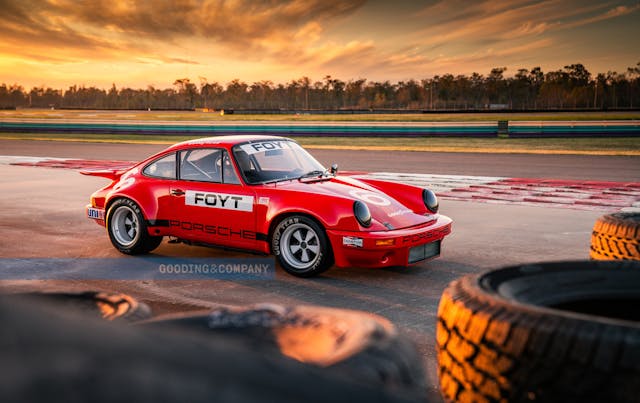
Long before the term “IROC” became synonymous with third-gen Camaros, a Porsche 911 carried the International Race of Champions moniker. In 1973 and 1974, motorsports champions like A.J. Foyt, Denny Hulme, and Richard Petty strapped themselves into identically-prepared Porsche 911 Carrera 3.0 RSR IROCs to determine who was the best of the best. Roger Penske was a driving force behind the creation of this motorsports all-star miniseries, and it included four races: three at Riverside International Raceway and a final round on the Daytona road course. Penske driver Mark Donohue is said to have had outsize influence in Penske’s decision to select the 911 for IROC, so it didn’t surprise many when Donohue won two of the three races at Riverside and went on to become the first IROC champion by winning at Daytona.
This example, chassis 9114600085, is one of just 15 RSRs built for the IROC series, originally piloted by USAC great Gordon Johncock, Can-Am champion Peter Revson, and four-time Indianapolis 500 winner A.J. Foyt. Revson fared best, finishing fourth in the second race at Riverside. Johncock managed a tenth and eleventh in this chassis, and Foyt suffered mechanical issues during the final race, taking sixth of six at Daytona. The car returned to the track in the 1976 and 1977 IMSA seasons, and again in four events in 1980, most notably the Daytona 24 Hours and Sebring 12 hours. The IROC series, meanwhile, switched to Camaros in 1975 in an effort to keep costs down.
Mechanically, the RSR IROC has been described as a hybrid between the 1973 2.8 RSR and the later 1974 3.0 RSR, with the exception of mechanical high-butterfly injection instead of the slide-valve injection found on other 3.0-liter cars. The engine is paired with a five-speed manual transmission.
Slathered in Guards Red, and sporting the names “Foyt” and “Porsche” on the side, this car would function equally well as a showpiece in a collection or hurtling through Daytona’s tri-oval at the Historic 24. Comer notes that there are strong run groups in vintage racing for the RSR IROCs, and he could see this finding a future home on the track. Gooding states that there is conflicting documentation from Porsche as to whether the current engine was the one originally installed in the car, but given its rarity, potential for use, and current demand we think Gooding will see every bit of the high side of its $1,100,000-$1,300,000 estimate.
1977 IROC Camaro
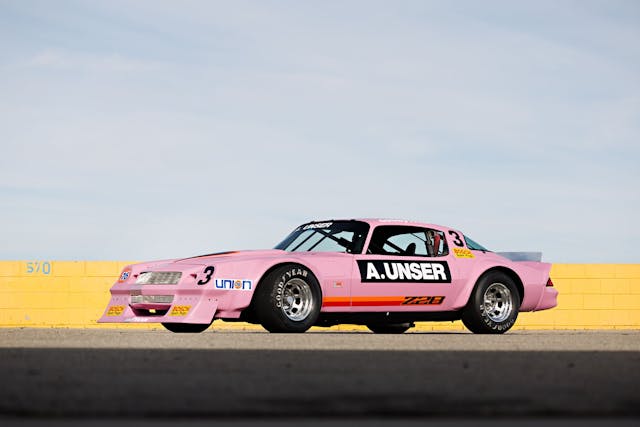
Three short years removed from the original Porsche RSR IROC, the 1977 IROC Camaro represented a complete pivot for the series. The schedule’s four races now included two road course appearances at Riverside International Raceway and two ovals—Michigan International Speedway and Daytona’s tri-oval (without the infield road course). After the one-year run for the Porsches, the series relied on Team Penske’s Trans Am preparation experience and used modified production Camaros for 1975 and 1976. The speedway banking proved too hard on those cars, and IROC was forced to come up with a new solution for the following year.
This 1977 IROC Camaro is a clean, race-winning example of the new-for-1977 IROC formula—a tube-frame NASCAR-style chassis with construction inputs from NASCAR legends Banjo Matthews and Holman Moody. The engine is a Traco-sourced 450-horsepower 350-cubic inch V8. It found the podium several times from 1977 through 1980, earning a win in the hands of NASCAR phenom Bobby Allison, second-place finishes achieved by Al Unser, Sr. and Emerson Fittipaldi, and a third place with Johnny Rutherford. It graced the Amelia Island Concours in 2005, 2017, and 2018, and it ranks as a solid race car-level restoration. Gooding projects a sale in the range of $250,000 to $350,000.
Without inciting a conflagration between the Porsche and bow tie tribes (I’ve owned both and am prepared to stand in the middle), the two IROCs highlighted here are an exercise in contrasts, and are good examples of desirable vehicles that shine for different reasons. The 1970s Porsche RSRs, particularly the IROCs, are among the most sought-after and entertaining drives on the planet. The Porsche would both show well and serve as a great addition at any vintage event. Meanwhile, the tube-frame Camaro’s chassis is comparatively common, but it does have the provenance of having some big names wheeling it to strong finishes, and it certainly wouldn’t be boring behind the wheel. It might not might not navigate the Esses at Watkins Glen as deftly as the 911, but it is a significant piece of American auto racing history. Plus, if you’re in a pinch while racing, you could probably find a replacement part for the drivetrain at the NAPA down the street from Mid Ohio.
1937 Riley Sprite Two Seater Sports

Don’t let the dainty lines of this Riley Sprite fool you— it’s a fiery and fierce little competitor. Riley apprentice William L. Innes drove it to a third place finish in the Under-1500cc class in the 1937 Rally Monte Carlo, and coworker Roger F. Peacock brought home a host of silver and bronze awards from time trials across England just prior to the outbreak of World War II.
It subsequently changed hands several times, and after some fits and starts, restoration was completed within the last few years. It was shown at the 2020 Amelia Island Concours, then entered and finished the 2020 and 2021 Mille Miglias. Now, with a pending application to the 2022 Mille Miglia, the little Riley is ready to push itself and its driver to the limit once again.
Prewar and early sports cars are enjoying a renaissance of late, with fresh attention coming from Generation X and Millennials. The rise in interest is well-warranted, too—driving a skinny-tired, open-air car like this is a feast for the senses unmatched by more modern transportation. A Riley Sprite could be the perfect fix to shake off the dullness of traction control and lane-keep assist.
Bonhams projects a sale price between $475,000 and $625,000. Despite a relative lack of comparable sales, we agree. Comer says of the Riley’s prospects: “The Mille Miglia is a bucket list item for many enthusiasts, and cars like the Riley are a great way for post-Boomer generations to have that experience. The Riley is good looking and a known quantity.”
1959 Porsche 718 RSK
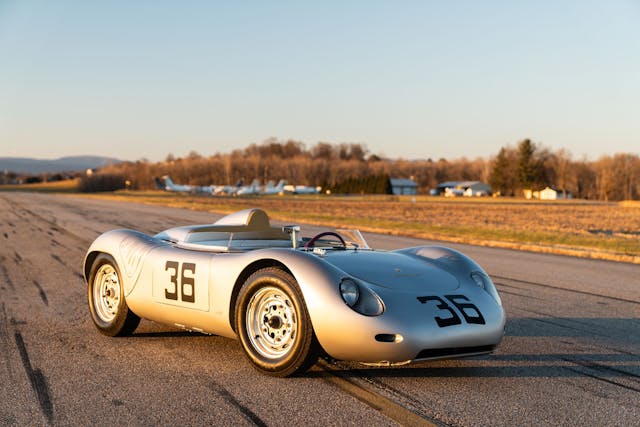
Call me a heretic, but mid-engine Porsches set my racing-infused brain alight in a way rear-engine models simply can’t. Hear me out; Porsche’s switch to a mid-engine layout, first with the 550 and then with the 718, took the racing world by storm and turned the little Stuttgart company into a racing powerhouse. Whether at Le Mans, Monte Carlo, or in the U.S. at myriad SCCA events, the 718 dominated. This particular 718 RSK, offered by Gooding & Company, is evidence: In 14 SCCA starts across 1959-1961, it secured ten class wins, nine overall podiums, and three overall victories.
Originally sold to and raced by Porsche dealership owner Emil Beck Pardee, it changed hands to other racers throughout the 1960s, and was bought by a former fighter pilot in 1970. By that point it had a pushrod 356 engine in place of the complex original four-cam unit, a relatively common occurrence among extensively raced Porsches of the era. A non-original four-cam engine did come with the car, and in 2014 it was rebuilt and reinstalled during the restoration by Vintage Motorcar Restorations. In 2018, this RSK made its restored debut at the Amelia Island Concours and was subsequently shown at the Porsche Experience Center in Atlanta.
Similar to the Riley, the RSK is an excellent vehicle to utilize for vintage tours. We could equally see this finding a home in a more static collection. At $2,500,000 to $3,500,000, the estimate for this RSK is in line with our thinking.
1951 Allard J2
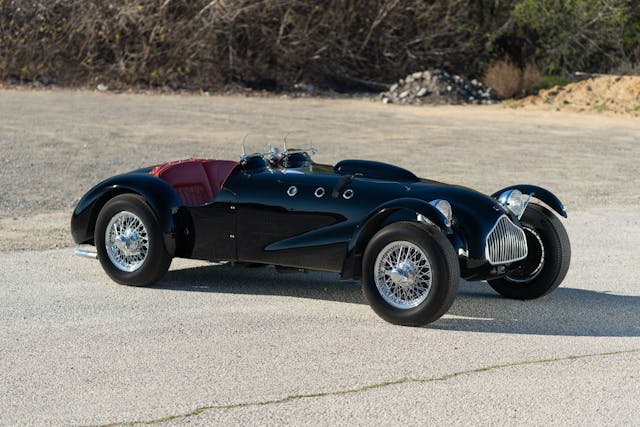
The mad science lab of postwar car culture yielded some impactful and impressive creations, and the cars that emerged from the tiny Allard Motor Company would have outsize influence in sports car racing across the globe. Sydney Allard built lightweight specials with American V8 power before World War II, and by 1945 he set up shop in London to create American-powered sports cars for racing and street use. It didn’t take long before the tiny company garnered attention from sports car fans. Carroll Shelby rose to racing fame in an Allard J2, and Zora Arkus-Duntov raced Allards at Le Mans. Both would apply lessons learned behind the wheel of their Allards to their future sports car successes. This Allard J2 offered by Gooding & Company is a clean example of Allard’s best-known model.
Purchased new by American privateer racer Jack Armstrong, this J2 saw double duty as Armstrong’s daily driver and his race car. Despite remaining mostly stock and lacking the race preparation of many other entries, the Allard racked up some impressive achievements in Armstrong’s hands—he finished second in two West Coast events and even managed to beat a 2.9-liter Alfa Romeo driven by Phil Hill in the second race of the 1951 Pebble Beach Cup. That’s quite a feat, as Allards are known to be a handful to drive at speed.
Allard shipped its cars to the U.S. without an engine, and the buyer could specify their preferred drivetrain. This example is outfitted with a 331-cubic inch Cadillac engine breathing through three Ford carburetors. It was also ordered with unique heat-extracting portholes from the factory. Armstrong had the car painted gray upon receiving it, but it has been returned to the black exterior with red leather as it left the factory.
Despite Allard being among the first to concoct the special sauce of American engines in a lightweight European chassis, or perhaps because of their reputation for requiring a skilled person behind the wheel, Allards stand in the shadow of Shelby’s more recognizable Cobras. Gooding estimates a sale price of $250,000-$325,000. The Allard market has been soft recently, so we are curious to see how this fares as it crosses the block.
1985 Camaro IMSA GTO

If Gordon Gekko is the Hollywood embodiment of ’80s excess, that decade’s IMSA racing could be the automotive equivalent. Rules geared toward encouraging innovation made for a lively and popular sports car series, and it produced some memorable, wild-looking cars. With its successful racing pedigree, technologically-advanced construction, and a stunning set of Radwood-approved deep-dish gold lace wheels, this Levi Garrett-sponsored 1985 Camaro IMSA GTO set to cross the block at RM Sotheby’s represents an excellent piece of 1980s racing culture.
Brad Francis built this Camaro for Peerless Racing in 1985, choosing to use a carbon fiber tub. Although common in sports car racing today, implementing a carbon tub put Francis at the forefront of his era. The car was fitted with multiple drivetrains in period but currently sports a 660-horsepower small-block Chevrolet V8 with Hilborn fuel injection and backed with a new G-Force five-speed transmission.
Jack Baldwin campaigned the car successfully from 1985-1987, garnering three victories and three second-place finishes in 1986. After 28 IMSA starts, the car retired with 11 top-ten finishes and helped Baldwin secure third place in the 1986 championship. Following an extensive three year-restoration that included refinishing the body in its 1987 Daytona 24 Hours livery, this IMSA Camaro won a class award at last year’s Amelia Island Concours.
“There’s a very active following for these cars, and they’re continuing to gain traction,” says Comer, who collects Roush Trans Am cars of the same era. “As a race car, they are incredibly safe and fun to drive. This generation of cars is starting to take off in the way that Trans Am cars from the late 1960s took off 15-20 years ago.”
Similar to the IROC Camaro, this IMSA example is projected to sell between $250,000 and $350,000. Given the recent love for all things ’80s and excellent racing history, we expect this Camaro to perform well.
